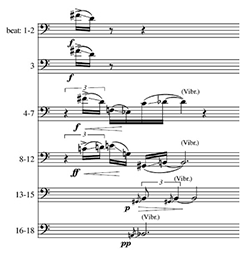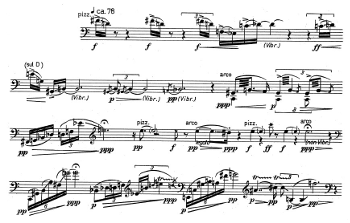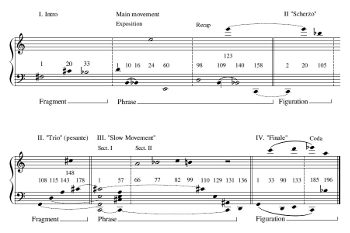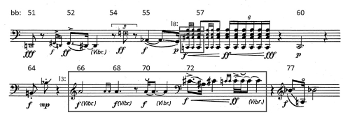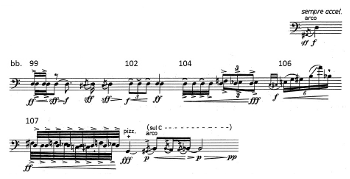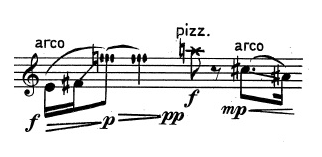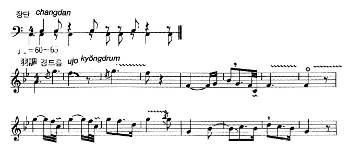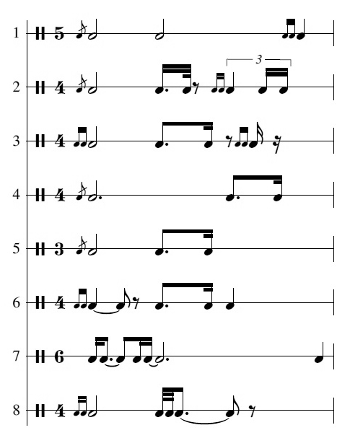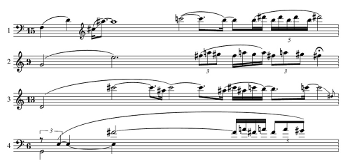Performing Cultural Hybridity in Isang Yun’s Glissées pour violoncelle seul (1970)
John W. Turner
KEYWORDS: Isang Yun, Glissées, Gilles Deleuze, Félix Guattari, Markand Thakar, Performance, Cultural Hybridity
ABSTRACT: This paper explores cultural hybridity in Isang Yun’s Glissées pour violoncelle seul (1970) using a framework based on ideas from the philosophy of Deleuze and Guattari. The discussion centers on five principal oppositions in the work: Taoist-inspired coalescence/dissolution and the Austro-German sonata cycle; Hauptton and twelve-tone techniques; the evocation of traditional Korean ornamentation and the concept of fixed pitch; the evocation of traditional Korean instruments and the cello timbre; and changdan rhythmic cycles and twelve-tone prose rhythms. Conclusions drawn from the consideration of each opposition then serve as the basis for comments regarding effective performance, using a framework based on ideas from conductor Markand Thakar.
DOI: 10.30535/mto.25.2.6
Copyright © 2019 Society for Music Theory
[1] The music of Isang Yun (1917–95) challenges performers with a fundamental philosophical problem: Is the expression of a culturally hybrid musical work external or internal? Does the action of the work exist in the juxtaposition of different musical cultures or in a patterning of tension and release that is largely independent of culture? German-South African composer Hans Huyssen (b. 1964) has articulated the former position, asking that the cultural identities in his music remain distinct, with the intention that “they would clarify and enhance their respective qualities and differences, which could then be treated with greater mutual understanding and respect” (1998, 6). Conductor Markand Thakar (b. 1955), however, has argued for the latter position, insisting that in directing the listeners’ attention to extramusical thoughts, the performer diminishes their experience of the music itself (2011, 164).
[2] Like many twentieth-century Asian composers, Yun was trained in the Austro-German/Western tradition. His interest in traditional Korean music grew only after he had completed his education in Germany (1957–59) (Kim 1999, 45–46). In his music after 1958, Yun, like Bartók, sought to recover a musical culture that had previously played only a minor role in his cultural identity, and then recreate it within the tradition of Westen modernism. Yun, like Bartók, sought to “rediscover a lost heritage,” one which had previously played only a minor role in his cultural identity, and then “use it to reinvent [Korean] musical culture within the larger practices of Western art music” (Bogue 2003, 50). Yun consistently argued that his music should be understood as a middle position: “I’m a man living today, and within me is the Asia of the past combined with the Europe of today. My purpose is not an artificial connection, but I’m naturally convinced of the unity of these two elements. For that reason it’s impossible to categorize my music as either European or Asian. I am exactly in the middle” (Duffie 1987). While this integration might make the sort of separation Huyssen describes seem inappropriate, Yun frequently used evocative titles and was at pains to describe the Korean/East Asian elements of his own work, suggesting that he regarded their distinction and contrast with Austro-German/Western elements as essential to its expression (see, for example, Yun 1978b).
[3] Even if such a separation could be easily achieved, however, cultural identity is a complex issue. “Western music” is not a single entity, but encompasses a wide range of strikingly dissimilar styles. Similarly, Korean music exists as a part of a multicultural organism with roots in China and branches in Japan. Yun’s own identity was subject to multiple influences as he grew up in Korea during the 1910–45 Japanese occupation, and he first studied Western music in Osaka (1935–37) and Tokyo (1939–41) (Kim 1999, 30–32). Accordingly, he generally preferred to describe his influences and the Hauptton technique as “Asian” or “Far Eastern” rather than as simply “Korean” (Yun 1978b, 57–58). Furthermore, while after his death Yun became a cultural icon in both the Republic of Korea and the DPRK, scholar Jin-Ah Kim has pointed out that during his lifetime, Yun’s projection of his cultural identity was not universally accepted in Korea, as to Koreans, “it simply did not sound Korean, rather it sounded western” (2015, 51).
[4] Thakar has argued that issues of cultural identity, extramusical associations, and even historic performance practice are ultimately irrelevant: performers achieve the “sublime experience of musical beauty” only through the perception of a musical work as an undivided whole, or as a unitarily apprehensible object (2011, 54). This is achieved through the creation of impulse (tension) and its consequent (or equivalent) resolution (168). While he is certainly correct, Thakar’s discussion is predominantly oriented toward the common-practice period. While he acknowledges that it is possible to create and resolve an impulse outside the tonal system, he does not pursue the topic in any detail (126). In Yun’s hybrid style and eccentric twelve-tone idiom, the means by which impulse and consequent resolution are effected are not entirely clear. Thus, some consideration of the culturally distinct elements in his music, particularly with regard to the mutual transformation that occurs in their combination, seems necessary for the performer. This paper explores such issues in Yun’s Glissées pour violoncelle seul (composed in 1970 and published in 1971), using a framework inspired by the ideas of philosophers Gilles Deleuze and Félix Guattari, and then drawing inferences regarding the patterning of impulse and consequent resolution to inform performance.
Deleuze and Guattari
[5] Deleuze and Guattari’s ideas are particularly appropriate for Yun’s music, as they facilitate discussion of complex interactions between heterogeneous elements. As they assert, “Music is a creative, active operation that consists in deterritorializing the refrain
[6] When milieus become expressive, a territory is formed. Deleuze and Guattari observe that the process of territorialization actually involves a decoding of the milieus, such that those that participate in the territory may be differentiated from others that do not (322). Bogue clarifies: “the territorializing act proceeds via a detachment, decoding, or ‘deterritorialization’ of milieu components and a reinscription, recoding, or ‘reterritorialization’ of those components as expressive qualities within a territory” (2007, 28). A territory, then, is an assemblage of milieus, and this territorialized assemblage constitutes a refrain.
[7] While the territorializing act is one aspect of refrains, they are not self-contained, but rather open to the world: again, Deleuze and Guattari explain, “one opens the circle a crack, opens it all the way, lets someone in, calls someone, or else goes out oneself, launches forth
[8] Glissées, then, exists in a liminal space created by interaction and subsequent deterritorialization of the two refrains. Milieus from the Korean/East Asian and Western /Austro-German refrains are prominent, but decoded. While they retain certain distinguishing characteristics, they lose others, which causes them to function differently. This view is consistent with a Taoist approach Yun frequently described in his own work: according to Chuang Tzu, the wise man would see that in each refrain, “there is both right and wrong
Example 1. Principal oppositions in Yun’s Glissées (pub. 1971)
(click to enlarge)
[9] In Glissées, the most prominent milieus from the Korean/East Asian refrain include coalescence/dissolution cycles derived from Taoist philosophy, the Hauptton technique, evocations of traditional ornamentation and instrumental timbres, and rhythmic cycling. Correspondingly, the most prominent milieus from the Western/Austro-German refrain include the sonata cycle, the twelve-tone technique, fixed pitch, the cello timbre, and prose rhythm. These may be understood as creating five principal oppositions, as shown in Example 1. Granted, the milieus in both refrains can, and often do, interact freely and in complex ways. The emergence of Haupttöne out of larger twelve-tone fabric, for example, generally indicates the apices of coalescence/dissolution cycles. Similarly, Haupttöne may be deployed to evoke the themes of a sonata form, serve as the subject of traditional ornamentation, and/or be articulated through rhythmic cycles. Deleuze and Guattari actually describe the interactions of milieus in terms of the rhizome, in which any milieu may decode any other through an interconnected network (1987, 7). For the purposes of this study, however, these five principal oppositions provide a convenient embarkation point for the consideration of the question of external or internal expression.
Coalescence/Dissolution Cycles vs. Sonata Cycle
[10] The first opposition in the work results from the interaction of coalescence/dissolution cycles and the sonata cycle. Coalescence and dissolution are another aspect of Taoist thought that Yun felt was important to understanding his music:
The beginning of my music is actually a continuation of something [invisible] that has already been ringing without sounding. Likewise, the seeming end of my music in fact belongs to the unheard sound of the future, and would continue to ring in the unheard sound (Yun 1985a, 30; quoted and translated in Kim 2012, 52).
The cycle of coalescence, or emergence from something “ringing without sounding,” and dissolution, or fading into “the unheard sound,” shapes conceptual units throughout the work. These units, which are evident on several time-scales, typically begin with fragments, coalesce into phrases, and then dissolve into figuration. (Within this schema, the term phrase refers simply to cohesive musical material on any time-scale.)
Example 2a. Glissées I, main movement, bb. 1–18
(click to enlarge)
Example 2b. Glissées I, main movement, bb. 1–56
(click to enlarge)
[11] The opening of the first movement proper illustrates this process in a short time-scale. Glissées is notated in unmetered quarter-notes throughout, and Example 2a shows a paradigmatic analysis of beats (hereafter bb.) in mm. 1–18, in which successive gestures have been arranged vertically to facilitate comparison (this passage is shown in its original notation in Example 2b). The conceptual unit begins with fragments: the two instances of the
[12] The opening of the first movement proper illustrates this process on a broader time-scale. Example 2b shows the first significant section, the exposition of the movement’s sonata form. From this perspective, the sustained pitch E5 clearly emerges as the phrase of the structural unit from the comparatively fragmentary material of bb. 1–25. This then dissolves into the figural material of bb. 41–56. In this unit and larger conceptual units, the rhythmic and dynamic characteristics found in the smaller time-scale are less systematic, but the gradual expansion of register from the narrow D4–
Example 3. Double structure of Glissées
(click to enlarge)
[13] Glissées as a whole also illustrates this process on even broader time-scales, with two large coalescence/dissolution cycles superimposed over the four notated movements. Example 3 presents an overview of the fifteen-minute work, showing the four movements, their tempos, their relative length in both time and beats, and their analogues in the sonata-cycle. The progression from fragments to phrases and figuration within each cycle is represented graphically for greater clarity. The first cycle begins with the halting, barely audible fragments of the introduction, coalesces in the sonata, and then dissolves throughout the scherzo. The second cycle begins with the “trio” of the second movement (marked “pesante” in the score), coalesces into the slow movement, and then dissolves in the finale, most dramatically in the coda, where an undifferentiated stream of sixteenth notes fades into silence.
Example 4. Glissées, double structure with relation to register
(click to enlarge)
[14] The general expansion of register observed in the section-length conceptual units is also evident in these two large-scale cycles. Example 4 shows a reductive analysis of the whole work, with the two cycles appearing on separate systems. In the example, open notes represent significant structural arrivals, particularly as defined by Haupttöne (which will be discussed further below) that define the active register. Closed notes represent temporary arrivals or pitches that principally maintain the active register, generally in the figuration sections. The beat number for each pitch is given between the staves. As the first cycle moves from fragment to phrase, the register expands outward from the opening
[15] The figuration sections, which effect dissolution, are by nature less clearly defined than the phrase sections. While the second movement primarily retains the register achieved in the first, the last movement more clearly expands the register to
[16] Since the coalescence/dissolution cycles unfold independently of the movement breaks, Yun carefully connected the four movements through divided presentations of the row (625301478E9T), overt emphasis of pitch invariants, or both.(1) Yun regarded such continuity as a characteristic of his style:
My music doesn’t have a beginning nor an end. You could combine elements from one piece into another piece very well. This is a Taoist philosophy. Music flows in the cosmos, and I have an antenna which is able to cut out a piece of the stream. The part which I’ve cut out is organized and formed through my own thought and body processes, and I commit it to paper. That’s why my music is always continuous—like the clouds that are always the same but are never alike [to] one to another. (Duffie 1987)
The image of tuning in to an existing, continuous stream of music provides a serviceable frame of reference for appreciating the double structure of Glissées. One can easily read the coalescence/dissolution cycles as a reflection of the natural “stream” of cosmic music, which was “organized and formed” into the work’s individual movements. Furthermore, Yun indicates in the work’s preface that these movements may be performed separately. While it might seem that such a performance would deprive them of the context required for their coherence, he effectively suggests that both the whole and the component parts are equivalent “pieces” of the stream; the whole is as fragmentary as the parts are complete and vice versa.
[17] As indicated in Example 3, the individual movements clearly evoke characteristics of a sonata cycle, giving the work a second, Western/Austro-German structure. In the process of interaction with the coalescence/dissolution cycles however, the individual movements appear altered or decoded, losing some of their essential characteristics; this forms the first instance of deterritorialization. In character and proportion, the first movement evokes a traditional sonata form, but dramatic opposition is effected through emphasis of the Haupttöne D,
[18] In terms of Thakar’s unitarily apprehensible object (in which impulse is resolved consequently), it seems clear that figuration builds tension as it coalesces into phrases, while figuration releases tension as it dissolves. In performance, fragments should “want” to pull together, as continuity is the goal. Conversely, figuration should “want” to dissolve. To put it another way, figuration and phrases are inherently active, or directed, while figuration is inherently passive. Any activity in the figurative sections is merely local and serves only to maintain the register. Schenker’s student Felix Salzer (1904–86) has suggested that the very act of identifying musical function is often sufficient to create an intuitive direction for performance. Direction to a goal, he points out, “will need different interpretive shadings” from passive or diffusive motion (1962, 17). Thakar’s directions are more specific: to project musical function on the levels closer to the surface, performers should use dynamic shading, while on the background levels they should use “tempo orientation” (2011, 118).
[19] The notation of Glissées generally supports Thakar’s directions. At the foreground and middleground levels, Examples 2a and 2b show a general move to louder dynamics as the phrases coalesce, and softer dynamics as they dissolve. At the background level, Yun’s tempo indications in the first coalescence/dissolution cycle also support Thakar, moving from the  =c. 60 of the introduction to
=c. 60 of the introduction to  =c. 78 in the main movement, and back to
=c. 78 in the main movement, and back to  =c. 60 in the second movement. Yun’s indications in the second coalescence/dissolution cycle, however, challenge this. As the pesante section of the second movement coalesces into the third movement, the tempo actually slows considerably, from
=c. 60 in the second movement. Yun’s indications in the second coalescence/dissolution cycle, however, challenge this. As the pesante section of the second movement coalesces into the third movement, the tempo actually slows considerably, from  =c. 60 to
=c. 60 to  =c. 46. Similarly, the tempo increases into the fourth movement dissolution, first back to
=c. 46. Similarly, the tempo increases into the fourth movement dissolution, first back to  =c. 60, and again into the coda, marked “schnell.”
=c. 60, and again into the coda, marked “schnell.”
[20] To account for situations like this, Thakar’s understanding of “tempo orientation” goes beyond simply the rate of pulse to incorporate the rate of information communicated to the listener. He explains, “That might mean adjusting the speed, and it might mean other factors as well, such as playing louder, or with a greater degree of volume inflections” (2011, 103). From this perspective, the details of the second cycle can support Thakar’s approach. The pesante section includes numerous swells from piano to forte, but their regularity reduces the overall level of contrast in the section and sustains a basic dynamic level of piano, which is inflected to forte, but does not show any overall growth until bb. 143–48, when the swells start building to fortissimo. Furthermore, since the notes generally begin at the low dynamic points of the swells, the articulation becomes less distinct. Both the regularity of the dynamic indications and the subtlety of the articulation serve to reduce the amount of information communicated, and thus allow the pesante to function as a large-scale coalescence, in spite of the faster pulse. In contrast, the third movement is surprisingly loud. This, with the percussive articulation provided by the guitar pick, as well as the frequent accents, microtonal inflections, and indications for vibrato, substantially increase the amount of information communicated to the listener and mitigate the very slow tempo. Finally, the fourth movement is generally very soft until b. 89, and the louder dynamics following are generally either the high points of swells, as in the pesante, or brief bursts that immediately decay into very soft dynamics. The loudest section, from bb. 135–50, is comparatively short and immediately yields to the coda, marked “immer decresc. bis zum Ende.” Finally, the opening phrases are generally long and feature sustained pitches, while the coda’s constant sixteenth notes provide very little differentiation or patterning. These elements, as in the pesante, serve to reduce the amount of information communicated and effectively allow the movement to function as a large-scale dissolution.
Hauptton Technique vs. Twelve-tone Technique
[21] The second principal opposition results from the interaction of the Hauptton and twelve-tone techniques. Yun regarded Hauptton technique as the fundamental element of East Asian music, and it is one of the most distinctive elements of his mature style. As he described:
Whereas in Western music only a complete group of notes arranged either melodically or harmonically has any importance, it is the individual note, the nucleus, which is the focus of attention in the music of Eastern Asia
. . . . For us in the East, the tone already lives in itself. Each tone is subjected to alteration from the moment it sounds until it dies away. It is endowed with ornaments, grace notes, vibrato, glissandi and changes in dynamic; above all, conscious use is made of the natural vibrations of every tone as a means of construction. (Yun 1978b, 57–58; emphasis in the original)
Example 5. Excerpt from “Yi Saenggang’s Taegŭm Sanjo” (Heo 2002, 93)
(click to enlarge)
In practice, Haupttöne begin with an introductory ornament, are varied through further ornamentation, timbral variation, and microtonal inflections, and then “settle” or “fade” away (Kim 1999, 74 and Kim 2012, 47–49). This concept is clearly evident in transcriptions of traditional East Asian/Korean music, as shown in Example 5, an excerpt from a Korean taegŭm sanjo. Here, a sustained
Example 6. Yun, Etüden für Flöte(n) solo I, mm. 1–9
(click to enlarge)
[22] Yun’s adaptation of the Hauptton technique is particularly evident in a series of solo instrumental works written in the 1970s and early 80s, beginning with Glissées (1971), and also including Piri (for solo oboe, 1973), Etüden für Flöte(n) solo (for solo flute, alto flute, piccolo, bass flute, and flute respectively, 1975), Königliches Thema (for solo violin, 1977), Salomo (for solo alto flute, 1978a), and Monolog (for solo bassoon, 1985b). The opening of the first flute etude, shown in Example 6, provides a representative instance. In this case, the Hauptton
Example 7. Yun, Königliches Thema, final variation, mm. 1–9
(click to enlarge)
[23] The Königliches Thema for solo violin is exceptional in the group, as it consists of a set of continuous variations on the theme from Bach’s Musical Offering. Accordingly, it is more overtly European/Austro-German in expression, but in the final variation Yun extends the note values of the theme and adds embellishing flourishes to evoke the Hauptton technique, as shown in Example 7, starting in the second measure.
Example 8. Yun, Glissées I, bb. 22–40
(click to enlarge)
[24] Glisseés is also unusual in this group of solo instrumental works for its length, complexity, and unmetered rhythm. While the other works similarly present overt Haupttöne by way of sustained whole and half-notes in duple-simple meters with grace-note flourishes, Glissées presents its Haupttöne in more complex rhythms in an unmetered simple time, with a wider range of timbre, dynamic, and articulation shading. The Hauptton E from the first movement, shown in Example 8, provides a representative instance. While this E5 is clearly a Hauptton, Yun has presented it in a variety of note lengths, punctuated by a nearly equal variety of rests, in irregular groupings of one, two, or three quarter-notes. The timbre includes bowed notes with and without vibrato, as well as both stopped (indicated by the “x” note-head) and sustaining pizzicato notes. The dynamics range from nearly inaudible to very loud. Finally, the articulation includes both the percussive stopped pizzicato and the almost indistinct bowed triple-piano.
Example 9. Glissées I, bb. 1–8, repetition within a series presentation
(click to enlarge)
[25] While still living in Korea in the early 1950s, Yun encountered Josef Rufer’s (1893–1985) book Die Komposition mit zwölf Tönen (Howard 2006, 130). He travelled to Europe in 1956 specifically to learn the twelve-tone technique, studied with Rufer himself and Boris Blacher (1903–75), and ultimately attended the Darmstadt courses in 1958. While he was aware of the avant-garde innovations of Boulez, Stockhausen, and others associated with the Darmstadt school, he ultimately rejected them (Kim 1999, 37–39). As he began incorporating East Asian/Korean elements into his style, his application of the twelve-tone idiom retained the flexible, pragmatic orientation of his teachers. In such works as Glissées and Piri, he simply cycles through his row forms, occasionally repeating or omitting pitches where he felt they were musically appropriate. This sort of repetition is illustrated in Example 9. In this instance, C and D are repeated on beat 8. While a repetition of the C–
[26] In addition to the original form, Yun uses only four permutations of the series in Glissées: P6, I3, I8, and I9. He generally constructs closely linked conceptual units from row forms whose hexachords share a greater number of invariant segments, while sharper breaks in the continuity appear where such invariants are fewer. In the second movement, for example, the conceptual units comprising the scherzo contain series forms P0 and I3. The pitch structure of these forms, with four invariants in corresponding hexachords, is virtually the same. Similarly, the pesante section, serving as the trio, consists of I9, I8, and P0, each of which shares four invariants in corresponding hexachords with its neighboring form. The shift from the scherzo to the trio, however, juxtaposes P0 and I9, which share only two invariants in corresponding hexachords. This is a significant break not only at the movement level, but also in terms of the larger structure, as it occurs between the two superimposed coalescence/dissolution cycles.
Example 10. Glissées I, bb. 9–21, invariants
(click to enlarge)
[27] Yun also uses invariants between complementary hexachords to extend sustained pitches or Haupttöne across row presentations and promote continuity at the phrase level. Example 10 shows Yun’s connection between the first two conceptual units of the first movement proper. The melodic prominence of invariants
Example 11. Glissées III, bb. 51–79, invariants A, C,
(click to enlarge)
[28] Similarly, Yun maintains continuity between the two principal conceptual units of the third movement through the invariants between complimentary hexachords of I8 and I3. Example 11 shows not only the extension of the sustained A3 beginning on beat 57, but also three other invariants: C,
[29] While Yun’s twelve-tone idiom in these examples is admittedly rudimentary (particularly for 1970!), as in the previous opposition, it exists in tension with, and is decoded by, the Hauptton technique. Indeed, the two milieus might at first appear fundamentally incompatible: the chromatic saturation of the twelve-tone idiom completely eradicates any sense of the traditional Korean melodic modes, while the consistent emphasis on single pitches, against which the series unfolds ornamentally, is antithetical to the concept of an ordered series (Perle [1962] 1968, 67). While Yun’s decision to reject the serial innovations of Darmstadt was certainly a factor in his simplification of the twelve-tone idiom, a more rigorous application of serial concepts might have conflicted too strongly with the Haupttöne and obstructed the creation of a liminal space.
[30] In terms of the broader pitch organization, the three Haupttöne of the introduction emphasize
Example 12. Glissées I, graph of principal main-tones and implied sonata form
(click to enlarge)
[31] In terms of both the overall proportion and the distribution of Haupttöne, the main body of the first movement resembles a sonata form. Example 12 shows a reductive analysis of the form, highlighting the progression of Haupttöne. The principal material (bb. 1–18) shows the same emphasis on
[32] The emphasis on D in the recapitulation suggests that Yun regarded it as the principal Hauptton of the movement, making the
[33] Yun’s tritone E–
[34] The second coalescence/dissolution cycle features an initial motion from
[35] The pitch and register patterning shown in Example 4 reflects the patterning of impulse and consequent resolution in Glissées. In the first coalescence/dissolution cycle, for example, impulse generally builds to the climax in bb. 98–110, and then resolves consequently by bb. 105–107 of the second movement. Intermediate graphs like Example 12 clarify how the component impulse/resolution pattern is integrated within the large-scale spans of the individual movements. There remains only a consideration of the performance of Haupttöne themselves.
Example 13. Glissées I, bb. 24–39, active elements of the main-tone E
(click to enlarge)
Example 14. Glissées I, bb. 98–111, main-tone D
(click to enlarge)
[36] Like melodies, Haupttöne are at once static and dynamic. In considering them as the basis for the structural graphs of Examples 4 and 12, they were regarded as prolongations of structural arrivals, and as such, inherently passive. On the surface level, however, Yun seems to have regarded them as active agents of expression. He described them as being alive, deriving their expression from the alterations effected by ornaments, vibrato, and the like, but presumably retaining their essential character as single pitches. Accordingly, it seems worthwhile for performers to approach them as self-contained conceptual units with the same impulse/resolution patterning as conventional melodies. Instead of creating a sense of direction from the changing notes, however, the ornaments and figuration should draw all attention back to the Hauptton itself. In a sense, the Hauptton is the active element and the changing notes are passive expansions or elaborations of its inherent “natural vibration” or energy. The Hauptton E5 in Example 8 would seem to support this conclusion. The Hauptton is activated through alternations in timbre and dynamics. Furthermore, each dynamic component executes a swell that reaches an independent climax, as shown in Example 13. Pitch alterations in this case support the dynamic inflections, moving down with the diminuendo in beat 30 and up with the fortissimo in beat 34. The Hauptton D3 in the recapitulation of the first movement (bb. 98–111), shown in Example 14, presents a more dramatic instance. Here, the ornaments grow from the microtonal inflections of bb. 102 and 104 to a veritable explosion of figuration encompassing the entire pitch series in bb. 106–108. Correspondingly, the dynamics get generally louder, the rhythm generally accelerates, and the articulation becomes more accentuated.
[37] While the Hauptton E could easily be performed such that the resolution is consequent to the impulse, it is unlikely that the flood of impulse generated in bb. 98–108 of the Hauptton D could be consequently resolved in the remaining three beats without a disruptive adjustment to the tempo. Accordingly, Yun continues the conceptual unit with a twenty-beat figural “tail” (concluding with the arrival on E6) to complete the impulse/resolution pattern.
Evocation of Traditional Ornamentation vs. Discrete fixed pitches
[38] The third principal opposition results from the interaction between East Asian/Korean and Western concepts of pitch itself. As made evident in the previous discussion, ornamentation is a fundamental component of Hauptton technique—in fact, unlike Western ornamentation, East Asian/Korean ornamentation, called nonghyŏn, is not an exterior decoration applied to structural tones, but rather grows from the structural tones themselves according to their position in the modal framework (Heo 2002, 44–46 and Kim 1999, 67). The twelve-tone organization of Glissées generally precludes any such specificity: the several instances of the Haupttöne D,
Example 15. Glissées II, bb. 41–44, an approximate pitch
(click to enlarge)
Example 16. Glissées IV, bb. 185b–93a, groups of approximate pitches
(click to enlarge)
[39] Yun generally preserves the series order in his evocations of nonghyŏn, and even the ubiquitous glissées of the title would not threaten the sense of series so long as the slides begin and end on fixed pitches. A difficulty arises in the fairly common use of “approximate pitches,” indicated by a square note-head consisting of three parallel vertical strokes, as shown in Example 15. These approximate pitches generally occur at the ends of slides and are notated as the correct pitches in the series. Since they occur in both loud and soft dynamics, they are clearly intended to sound; the slide should not simply end in silence as the pitch is reached. The combination of imprecision (an approximate pitch) and precision (in this case,
Evocation of Traditional Instrumental Timbre vs. Cello Timbre
[40] The ornaments Yun evokes do not exist in isolation; they suggest the techniques and characteristics of the traditional instruments from which they originated. Previous studies have connected both Glissées and Yun’s string writing more generally with two traditional Korean instruments: the haegŭm, a two-string spike fiddle derived from the Chinese erhu, and the kŏmun’go, a six-string zither played with a bamboo plectrum (Choy 2010, 62; Kim 2011, 1; Ko 2008, 36; and Song 2008, 25). Thus, the fourth principal opposition results from the interaction between evocations of traditional instruments and the timbre of the cello.
Example 17. Glissées III, bb. 125–43, evocation of kŭmun’go ornamentation
(click to enlarge)
[41] Yun identified his instrumental evocations specifically in other works, such as Piri (1973) and the earlier string orchestra suite Colloïdes sonores (1964a), which has movements titled “Haegum” and “Geomungo” (an outdated transliteration of kŏmun’go). No such indications are present in Glissées, in the score or in the performance notes. While this might make the connections with specific instruments somewhat presumptive, scholar Songyoung Kim asserts that this was a common practice of Yun’s (2011, 1). Certainly, the association with the bowed haegŭm seems justifiable, as it has the most in common with the cello timbre. The association with the timbrally distinct kŏmun’go is also plausible, as Yun calls for the third movement to be performed with a guitar pick (Plektrum). The resulting sound is markedly different from the traditional cello timbre, and thus suggests an evocation. Not only does the thin, percussive sound produced by the pick evoke the sound of the kŏmun’go, but the broad pitch fluctuations, particularly in bb. 125–43 (Example 17), also suggest the characteristic ornamentation of Asian zithers created by pressing on the strings behind the tuning bridges after they have been sounded.
Example 18. Glissées I, bb. 140–50, the evocation of the taegŭm
(click to enlarge)
[42] Yun also included several passages that feature col legno tratto, an extended technique that involves drawing both the hair and the stick of the bow across the strings. The resulting sound, while used occasionally in contemporary literature, remains comparatively exotic and thus suggests another evocation. It is tempting to connect this timbre with that of the taegŭm, a Korean bamboo flute. The sound created by the friction of the bow stick suggests the distinctive “buzzing” timbre of the taegŭm, created by the vibration of a thin membrane extracted from the inside of a reed or bamboo stalk (Heo 2002, 6). Furthermore, the first use of this technique (Example 18) also features sharp, initial accents. These evoke the articulation of the taegŭm, which is achieved through airspeed rather than tonguing (Heo 2002, 47). In the example, “(a.)” indicates “arco,” the conventional use of the bow, and “(c.l.)” indicates col legno tratto.
[43] If it was intentional, the evocation of the haegŭm, kŏmun’go, and taegŭm has significant allusive value. They are among the oldest Korean instruments and were prominent in chŏngak (“correct music”), which was the aristocratic music of the Chosŏn dynasty (1392–1910). They are also featured in the fifteenth-century chamber music anthology Yŏngsan hoesang (Howard 1996, 17, 35, and 45). Thus, the evocation of these timbres connects the work allusively with an archetype of Korean music. Since the Western cello can only approximate their timbres however, it also decodes them, freeing them from their traditional genres and repertoires. With the cello, Yun may evoke any of the three instruments as he needs them, and thus achieve greater timbral contrast and a wider associative field.
[44] Of course, these evocations equally decode the traditional timbre of the cello and challenge its traditional role in Western/European chamber and orchestral music. In realizing these evocations, cellists would be justified in putting aside accepted expectations for an “ideal” cello sound and using the Korean traditional instruments as models for inspiration for experimentation. It seems reasonable that the cello timbre should be altered in effecting the evocations as much as the Korean instruments themselves are altered by the evocations.
Changdan (Rhythmic Cycles) vs. Prose Rhythm
Example 19. Yi Saenggang’s Taegŭm sanjo, excerpt (Heo 2002, 102)
(click to enlarge)
[45] The final principal opposition in Glissées is a result of the interaction between changdan, or rhythmic cycles of Korean traditional music, and the prose rhythms of the twelve-tone technique. Changdan (literally “long-short”) are underlying rhythmic patterns performed on the changgo, an hourglass-shaped, double-sided drum (Howard, Chae-suk, and Casswell 2008, 60). Modern transcriptions, as in the excerpt from Yi Saenggang’s Taegŭm sanjo (Example 19), generally show the underlying changdan pattern, and then present the melodic part, divided into metric units corresponding to the pattern. The changdan merely provides the structure for the changgo drummer, whose improvisations support the melodic part while articulating the strong beats of the cycle. Since the literature incorporating changdan is transmitted orally, the patterning is rarely as regular as the transcriptions make it appear. Howard, Chae-suk, and Casswell also acknowledge that, in performance, “there is a tendency to reduce phrase lengths,” which undermines the changdan’s periodicity, and discuss several such deviations in a recorded performance of kagayum sanjo (2008, 60–64 and 82).
[46] While several studies of Yun’s music mention changdan as an important element (see Kim 1999, Ko 2008, and Choy 2010, for example), they generally provide only vague indications as to how rhythmic cycling is employed. Kim (1999, 55–57 and 80–86) even implies that the evocations of changdan in Yun’s Loyang für Kammerensemble (1964b) and Gasa für Violine und Klavier (1965) suggest only the changgo’s timbre or its function in providing continuity, and play no significant role in the actual rhythmic structure. In the case of Glissées, any evocation of specific changdan would necessarily be rather abstract; in Loyang and Gasa, the changgo is evoked by accompanying instruments, while Glissées is unaccompanied. While Yun employs occasional percussive effects, their infrequency and wide separation makes any evocation of the changgo unlikely. Furthermore, the changdan discussed in Howard, Chae-suk, and Casswell 2008 are predominantly in compound meter, while Glissées is in simple time and unmetered throughout.
Example 20. Glissées I, bb. 1–13 and II, bb. 1–5, parallel rhythmic patterning
(click to enlarge)
[47] This is not to say that Glissées is without rhythmic patterning. Indeed, many conceptual units begin with parallel rhythmic gestures, as demonstrated in Example 2a and Example 20. Yun’s parallel openings suggest a rhetorical “thesis-elaboration” structure, which facilitates apprehension of the musical action of each conceptual unit. It is also significant that the patterning is frequently disrupted (as in Example 20a) or inexact (Example 20b). In Example 20a, the pattern of 3 + 4 eighth notes is immediately challenged by the off-beat triplet on beat 8. This slight hesitation suggests the improvisatory aspect of changdan and is elaborated even further in bb. 12 and 13, in which the first attack point is delayed by a sixteenth and the second anticipated by the triplet. Similarly, each gesture in Example 20b includes five short notes followed by a long note, but the subtle acceleration from the quintuplet of beat 1 to the sextuplet of beat 4 keeps the patterning from becoming overly mechanical.
[48] These deviations, however, are also consistent with the conception of twelve-tone rhythm held by Yun’s teacher Rufer and others in his circle. In Die Komposition mit zwölf Tönen, Rufer asserts that rhythm in the twelve-tone style ideally “prevents too great emphasis on the strong beats of the bar,” which, as he explains, often interferes with the musical purpose (1954, 132). Ernst Krenek, who contributed a brief reflection to Rufer’s “Appendix I,” warned in his own book Studies in Counterpoint Based on the Twelve Tone Technique that “rhythmic liveliness is a vital requirement of the style under consideration
Example 21. Glissées III, bb. 1–33 (rhythm only), flexibile rhythmic patterning
(click to enlarge)
[49] Since Changdan cycles are more conceptual than actual, Howard, Chae-suk, and Casswell, who also approach traditional Korean music through the lens of Deleuze and Guattari, see them as in a “perpetual state of transcoding” (2008, 82). That is, as performers alter changdan patterns through improvisation and truncation, they act as continuously decoded milieus. In Glissées, they also act as milieus, but, out of their context of improvisation and oral tradition, they are continuously decoded by the prose rhythms Yun inherited from Rufer. Thus, rhythmic cycles, when present, appear as a series of flexible rhythmic shapes. At the beginning of the third movement, for example, Yun presents eight iterations of an essential pattern consisting of an ornamented long note, a dotted rhythm, and a short, sometimes ornamented punctuation. Example 21 presents a paradigmatic analysis of these iterations, arranged vertically to facilitate comparison. The essential pattern is presented most clearly in iterations 3 and 6. Iterations 1, 7, and 8 omit the dotted rhythm, while iterations 4 and 5 omit the punctuation. Iteration 2 is the least typical, presenting the dotted rhythm at double speed and expanding the punctuation to five notes. Throughout the passage, Yun varies the pattern further by changing the overall length from three to six quarter beats, changing the number of grace notes, and/or slowing them to sixteenth or thirty-second values, as in iterations 7 and 8. Yet, the essential patterning remains perceptible throughout the passage.
Example 22. Glissées IV, bb. 26–70 (pitch and rhythm only), flexible rhythmic patterning
(click to enlarge)
[50] An even more developed example occurs in bb. 26–70 of the last movement, shown in Example 22. Here, the essential pattern consists of an initial ascent to a sustained tone followed by an ornamental flourish of three to five notes. These figures resemble Haupttöne in concept, but in the context of the last movement’s dissolution, their comparative brevity deprives them of sufficient stability to be any more than reminiscences of Haupttöne. The four iterations represent a wider variety of overall length than the iterations of Example 21, ranging from six to fifteen quarter-beats. Instances 1 and 4 include ornamentation in the initial ascent, while instances 1 and 3 include ornamentation in the sustained note prior to the closing flourish. Finally, the specific rhythms and intervals of the four closing flourishes are significantly different in all four instances. Yun’s rhythmic cycling clarifies the foreground grouping structure, particularly in figuration sections such as Example 22, or in the scherzo, where clear Haupttöne are absent.
Conclusion
[51] Returning to the original philosophical question, expression in Yun’s Glissées is certainly internal, as Thakar (2011) asserts: an effective performance depends ultimately on the creation of a unitarily apprehensible object through impulse and its consequent resolution. However, this internal expression is significantly clarified through a consideration of the external features of the work. While the East Asian/Korean and Austro-German/Western refrains are not perhaps as distinct as the refrains that Huyssen seems to expect (perhaps as they are found in his own work), regarding them in terms of deterritorialization acknowledges the complexity of cultural identities and avoids essentialist stereotypes. Understanding Glissées as occupying a liminal space reveals a background structure of coalescence/dissolution cycles defined by the emergence and dissolution of Haupttöne, which exist in tension with the four notated movements. These Haupttöne are arranged into intervallic or linear sequences that provide a framework for the creation of impulse and its consequent resolution at the middleground levels. Finally, the evocation of traditional ornamentation and instruments brings more variety to the foreground, and rhythmic cycling complements the Haupttöne and brings greater clarity to the grouping of the figural sections.
[52] In his gloss on Deleuze and Guattari, Bogue explains that “the Modern artist’s effort remains that of creating a people as Dividual [collective] multiplicity, but such a collectivity must increasingly be conceived of as a future people” (2003, 48). It might be argued that Glissées, when it was written, was a work without an audience: the liminal space Yun created from his experiences of Korean/East Asian identity through the lens of Japanese and European hegemonies, was simply too personal. As noted previously, Yun’s work was initially met with resistance in Korea, and indeed, after the debut recording of Glissées in 1975 by Siegfried Palm (1975) (the work’s dedicatee), the work was not recorded again in its entirety for nearly forty years.(3) However, Yun’s “future people” may well have arrived. Sociologist Jan Nederveen Pieterse has argued that hybridity “is a terminology and sensibility of our time in that boundary and border-crossing mark our times” (2001, 238). In the last decade, five new recordings have appeared (Brand 1991; Cheah 2014; Grenet 2015; Haimovitz 2018; and Meissner 2014), and the work has served as the subject of two doctoral dissertations (Ko 2008; Song 2008). While this new popularity might well be attributable to Palm’s teaching legacy and Korean Nationalism, it is tempting to read this recognition in light of the growing prominence of the hybrid J-pop and K-pop genres, or music from the Final Fantasy franchise, all of which is interesting precisely for the ways in which it freely combines elements drawn from a broad range of contrasting styles, eras, and countries. At their best, these hybrid pieces open creative possibilities and affirm Pieterse’s assertion that “hybridity is deeply rooted in history and quite ordinary” (2001, 221).
John W. Turner
High Point University
Department of Music
One University Parkway
High Point, NC 27268
wellesz31@gmail.com
Works Cited
Bogue, Ronald. 2003. Deleuze on Music, Painting, and the Arts. Routledge.
—————. 2007. Deleuze’s Way: Essays in Transverse Ethics and Aesthetics. Ashgate.
Choy, Sonia. 2010. “The Fusion of Korean and Western Elements in Isang Yun’s Konzert für Flöte und kleines Orchester.” DMA diss., University of Georgia.
Deleuze, Gilles, and Félix Guattari. 1987. A Thousand Plateaus: Capitalism and Schizophrenia. Translated by Brian Massumi. University of Minnesota Press.
Duffie, Bruce. 1987. “Composer Isang Yun: A Conversation with Bruce Duffie.” http://www.bruceduffie.com/yun.html
Feliciano, Francisco. 1983. Four Asian Contemporary Composers: The Influence of Tradition in Their Works. New Day Publishers.
Heo, Jong-In. 2002. “The Korean Transverse Flute Taegŭm and Its Music Taegŭm Sanjo.” DMA diss., Florida State University.
Howard, Keith. 1996. Korean Musical Instruments. Oxford University Press.
—————. 2006. Creating Korean Music: Tradition, Innovation and the Discourse of Identity. Perspectives on Korean Music, Volume 2. Ashgate.
Howard, Keith, Chae-suk Yi, Nicholas Casswell. 2008. Korean Kayagŭm Sanjo: A Traditional Instrumental Genre. Ashgate.
Huyssen, Hans. 1998. Ugubu (rising and falling
Kim, Jeongmee. 1999. “The Diasporic Composer: The Fusion of Korean and German Musical Cultures in the Works of Isang Yun.” PhD diss., University of California at Los Angeles.
Kim, Jin-Ah. 2015. “Cultural Transfer as a Branch of Research for Music Sociology and Music Anthropology.” International Review of the Aesthetics and Sociology of Music 46 (1): 43–53.
Kim, Sinae. 2012. “Isang Yun and the Hauptton Technique: An Analytical Study of the Second Movement from Duo für Violoncello und Harfe (1984).” Master’s thesis, University of Ottawa.
Kim, Songyoung. 2011. “The Concept of ‘Unity’ in Isang Yun’s Königliches Thema für Violine solo.” DMA diss., University of North Texas.
Ko, Jee Yeoun. 2008 “Isang Yun and His Selected Cello Works.” DMA diss., Louisiana State University.
Krenek, Ernst. 1940. Studies in Counterpoint Based in the Twelve Tone Technique. G. Schirmer.
Merton, Thomas. 1965. The Way of Chuang Tzu. New Directions.
Pieterse, Jan Nederveen. 2001. “Hybridity, So What? The Anti-Hybridity Backlash and the Riddles of Recognition.” Theory, Culture and Society 18 (2–3): 219–245.
Perle, George. (1962) 1968. Serial Composition and Atonality: An Introduction to the Music of Schoenberg, Berg, and Webern. University of California Press.
Rufer, Josef. 1954. Composition with Twelve Notes Related Only to One Another. Translated by Humphrey Searle. Barrie and Rockliff.
Salzer, Felix. (1952) 1962. Structural Hearing: Tonal Coherence in Music. Dover.
Song, Injung. 2008. “In-depth study of Isang Yun’s Glissées pour violoncelle seul.” DMA diss., Boston University.
Thakar, Markand. 2011. Looking for the “Harp” Quartet: An Investigation into Musical Beauty. University of Rochester Press.
Yun, Isang. 1964a. Colloïdes sonores für Streichorchester (1961). Bote and Bock.
—————. 1964b. Loyang für Kammerensemble (1962). Bote and Bock.
—————. 1965. Gasa für Violine und Klavier (1963). Bote and Bock.
—————. 1971. Glissées pour violoncelle solo (1970). Bote and Bock.
—————. 1973. Piri für Oboe solo (1971). Bote and Bock.
—————. 1975. Etüden für Flöte(n) solo (1974). Bote and Bock.
—————. 1977. Königliches Thema für Violine solo (1976). Bote and Bock.
—————. 1978a. Salomo für Alt-Flöte oder Grosse Flöte (1977/78). Bote and Bock.
—————. 1978b. “The Contemporary Composer and Traditional Music.” The World of Music 20 (2): 57–60.
—————. 1985a. Bewegtheit in der Unbewegtheit: über meine kompositorische Entwicklung in Europa (Motion Midst Rest: About My Compositional Development in Europe). Korea Forschungsgemeinschaft [Offenbach am Main].
—————. 1985b. Monolog für Fagott (1983/84). Bote and Bock.
Discography
Discography
Brand, Ulrike. 1991. Track 3 on Violoncello. 1994. Self-published.
Cheah, Elena. 2014. Figment. Costa Records LC 29661 CR 003, CD.
Grenet, Benoît. 2015. Yun Isang: Musique de chambre. Label-Hérisson LH12,CD.
Haimovitz, Matt. 2018. Isang Yun: Sunrise Falling. Oxingale Records. PTC 5186693, CD.
Hussong, Stephan, Zygmunt Krauze, Klaas Hoek, et al. 1990. Perspectives: 25 years of International Gadeamus Interpreter’s Competition. Gadeamus CJX8499.
Meissner, Christina. 2014. When! Querstand VKJK 1415, CD.
Palm, Siegfried. 1975. Zeitgenössische Cellomusik. Deutsche Grammophon 2530 562, LP.
Footnotes
1. The presentation of P0 at the conclusion of the first movement is interrupted at the eighth pitch, for example, and is resumed at the beginning of the second. The only exception is the connection between the third and fourth movements, in which I3 breaks off after the first hexachord and is never completed. The fourth movement starts fresh with I9.
Return to text
2. See Song 2008, 31–32, for a general discussion and several examples in the analyses of individual movements.
Return to text
3. Cellist Michael Bach recorded the third movement in 1990 for Perspectives: 25 years of International Gadeamus Interpreter’s Competition (Hussong, Krauze, Hoek, et. al. 1990).
Return to text
Copyright Statement
Copyright © 2019 by the Society for Music Theory. All rights reserved.
[1] Copyrights for individual items published in Music Theory Online (MTO) are held by their authors. Items appearing in MTO may be saved and stored in electronic or paper form, and may be shared among individuals for purposes of scholarly research or discussion, but may not be republished in any form, electronic or print, without prior, written permission from the author(s), and advance notification of the editors of MTO.
[2] Any redistributed form of items published in MTO must include the following information in a form appropriate to the medium in which the items are to appear:
This item appeared in Music Theory Online in [VOLUME #, ISSUE #] on [DAY/MONTH/YEAR]. It was authored by [FULL NAME, EMAIL ADDRESS], with whose written permission it is reprinted here.
[3] Libraries may archive issues of MTO in electronic or paper form for public access so long as each issue is stored in its entirety, and no access fee is charged. Exceptions to these requirements must be approved in writing by the editors of MTO, who will act in accordance with the decisions of the Society for Music Theory.
This document and all portions thereof are protected by U.S. and international copyright laws. Material contained herein may be copied and/or distributed for research purposes only.
Prepared by Sam Reenan, Editorial Assistant
Number of visits:
5946

